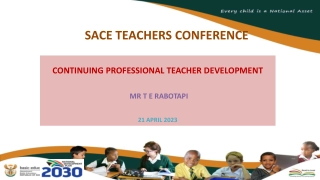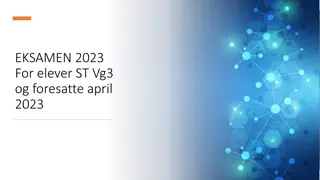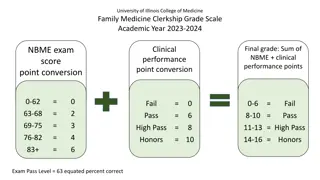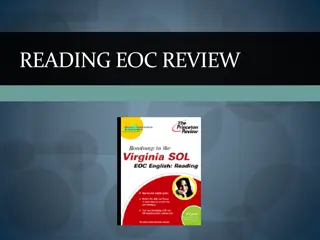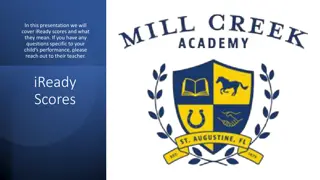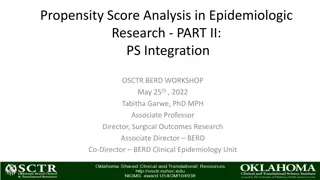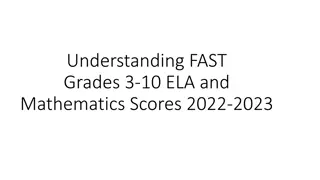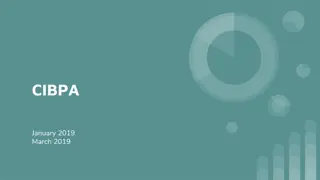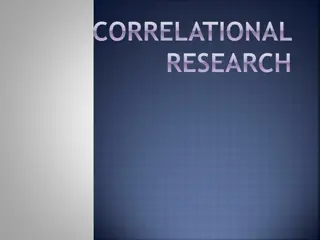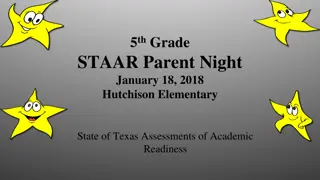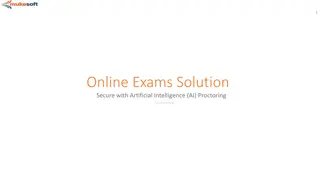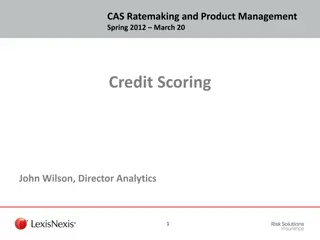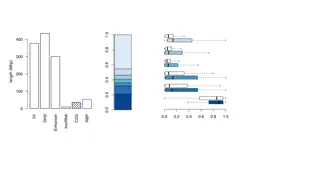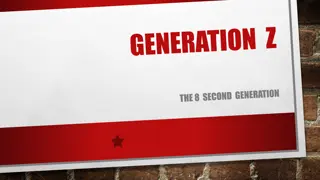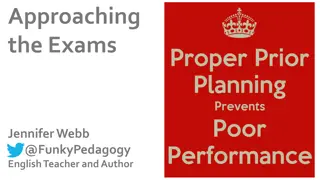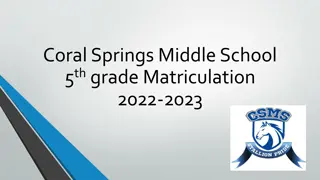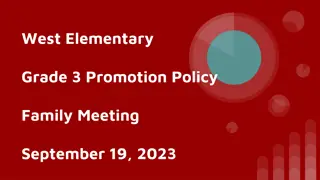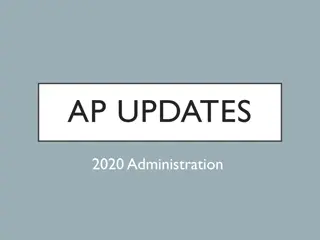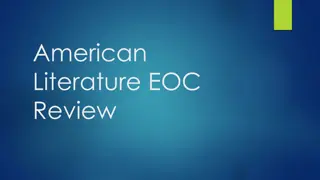Teacher-Made Art Exams Impact on 5th Grade EOC Scores
This study explores the effectiveness of teacher-made art exams in preparing 5th-grade students for End of Course Exams (EOC) in art. The research compares the outcomes of students who received traditional multiple choice exams with those who were assessed using varied measurements. Additionally, insights from the 2014-2015 EOC results and implications for future assessment strategies are discussed. Questions raised include the influence of teacher-made exams on student performance, potential benefits of diverse assessment methods, and comparisons of district-wide scores.
Uploaded on Mar 01, 2025 | 0 Views
Download Presentation

Please find below an Image/Link to download the presentation.
The content on the website is provided AS IS for your information and personal use only. It may not be sold, licensed, or shared on other websites without obtaining consent from the author. Download presentation by click this link. If you encounter any issues during the download, it is possible that the publisher has removed the file from their server.
E N D
Presentation Transcript
Teacher-Made Art Exams and the End of Course Exam in Art for 5th Grade Deanna Filiault Dr. Thomas M. Brewer 2015 FAEA Presentation
Introduction During the 2014-2015 school year, the district I work for required all visual art elementary teachers to give their 5thgrade students an End of Course Exam (EOC). This exam was created by the school district I work for. The multiple choice exam was based on the NGSSS.
Current Condition/ Status Art assessments have been a national, debatable topic for years. It is important to give students the opportunity to authentically respond by providing multiple measurements. Misconception about art assessments within the field (art shouldn t be tested, art assessments take away from creativity).
Purpose To determine whether or not a quality teacher-made exam that contains contemporary art, an art making component, multiple choice, and short answers would result in higher scores and better prepare 5thgrade students for the End of Course Exam in art. One 5thgrade class would get a basic, multiple choice, pencil and paper teacher made exam and another 5thgrade class would get an exam with multiple measurements.
Purpose Additionally, results from the EOC exam in art that my 5th grade students took during the first year it was required (2014-2015) will be examined. Implications from data will be discussed. I will reflect on how the results from the pilot year has determined what I will do differently the next school year and what I have learned by creating my own teacher made assessments using a phenomenological approach.
Questions 1.) Do teacher-made art exams better prepare students for the EOC at the end of the year? 2.) Is there a difference in scores on the EOC between students who received four quality made art teacher exams and students who received four teacher made multiple choice exams? 3.) What could be offered to art teachers that aid them in creating and implementing their own art tests? 4.) How do my 5th grade students results from the first year taking the EOC in art compare to the district scores? 5.) Is there a significant difference in scores on the EOC in art for the 2014-2015 school year between my 5thgrade students and all other 5thgrade students in the district?
Methodology One 5thgrade class would get four, teacher made multiple choice art exams during the school year. The second 5thgrade class would also take 4 exams throughout the year. However, the second fifth grade class would receive an art exam with multiple measurements that included contemporary art, an art making component, multiple choice, and short answer. Both classes would be taught the same material.
Results Out of the 30 questions, my students answered 23 questions correctly at a higher percentage when compared to the district . The mean of my students scores that scored answers correctly was 71.4. Alternatively, the mean for the district for students who scored answers correctly was 63.3. This is a 8.1% difference, which is a quite a large gap.
Results Challenges Although I was able to get some statistical data, there were restrictions. I did not have access to the sample population size (number of 5thgraders in the county that took the EOC in art). Had I been able to access that information, a t-test could have been performed to provide more statistical data that could help me better state whether or not there was a significant difference.
Percentage of My Students that Answered the Question Correctly Percentage of Students in the District that Answered the Question Correctly Benchmark Item Difficulty Difference VA.5.O.1.1 Use the structural elements of art & organizational principles of design to develop content in artwork. Average 90% 70% 20% Average 80% 49% 31% Challenging 87% 39% 48% Challenging 49% 34% 15% Average 56% 53% 3% Challenging 36% 27% 9% Easy 82% 82% Same Easy 95% 93% 2% Easy 80% 72% 8% Challenging 50% 32% 18% Average 55% 54% 1% Average 61% 48% 13%
Implications for Teaching and Constructing Assessment I believe this study could help other art educators see the value in making quality teacher made exams. When creating an art exam, it is important to: Create an exam that allows students to display their skill level by using multiple measurements. Shoot for quality rather than an expedited endeavor. Art assessments can help art teachers learn: What their students understand and do not understand
Implications for Teaching and Constructing Assessment Teacher-made art assessments can be a learning device for students. My results imply that: My teacher-made tests could have attributed to higher scores on the EOC. My teacher-made tests seemed to significantly improve my students scores on the EOC. The original, multiple choice teacher-made tests I created helped students to perform better on the EOC, but my revised test is better. My revised test is better because it gives students multiple ways to express their comprehension on the standards that were taught throughout the year (multiple choice, short answer, matching, creating a work of art).
What I Have Learned Teacher-made assessments are crucial. It is very easy to teach students how to make an almost imperfect work of art. However, educating students on how to make works of art that have meaning they are able to articulate is arduous, yet rewarding. My revised test is much more sophisticated than my original test.
What I Have Learned Making art exams is no easy task and can actually be very strenuous. Creating quality art exams requires a lot of time and research. Assessing students with exams that include assorted approaches to measure students capabilities is necessary to provide a well- rounded art education.
Quarter 1 Art Exam for 5th Grade (Original Q1 Exam) 1.) What are the 4 steps for doing an art critique called? Circle the correct answer. A.) Think, Tell, Listen, Judge B.) Describe, Analyze, Interpret, Judge C.) Describe, Analyze, Interpret, Discuss D.) Talk, Discuss, Listen Analyze 2.) How can you show respect to other s works of art? A.) Giving a compliment B.) Saying something positive C.) Telling them their work is creative D.) All of the answers above are correct 3.) Match the Elements of Art with the correct definition and picture: ___ Line ___ Space ___ Color ___ Texture
4.) Match the Elements of Art with the correct picture: ___ Form ___ Shape ___ Value 5.) Match the Principles of Art to their correct definitions: ___ Contrast ___ Balance ___ Emphasis ___Pattern .A) B.) Using oppostite elements C.) When an element repeats D.) Focal point
6.) How would you clean up the following materials? You may use an answer more than once. ___ Chalk ___ Clay ___ Water Spill A.) Wet paper towel B.) A Dry paper towel
Quarter 1 Art Exam for 5th Grade (Revised Q1 Exam) 1.) Critique the work of art below using Feldman s Method. Teresa Hubbard & Alexander Birchler, Falling Down, 1996 Describe____________________________________________________________________________________________________________ ___________________________________________________________________________________________________________________ Analyze____________________________________________________________________________________________________________ ___________________________________________________________________________________________________________________ Judge______________________________________________________________________________________________________________ ___________________________________________________________________________________________________________________ Interpret____________________________________________________________________________________________________________ ___________________________________________________________________________________________________________________
2.) How can you show respect to others works of art? A.) Giving a compliment B.) Saying something positive C.) Telling them their work is creative D.) All of the answers above are correct 3.) Based on the meaning you discovered in Teresa Hubbard and Alexander Birchler sFalling Down, create a work of art that represents what you believe Falling Down is about. Your art MUST illustrate the following Elements of Art: Shape, space, color, and texture. You may use the 8 x10 paper, pencil, eraser, and color pencil provided for you. After you complete your work of art, you must write 1 paragraph describing what your art work is about and how it relates to the meaning you discovered in the work Falling Down.
4.)Match the following three Elements of Art with the art work that fits them best: ____FORM ____LINE _____VALUE
A.) Carrie Mae Weems, Untitled (from Kitchen Table), 1990
B.) C.) Buzz Spector, Toward A Theory of Universal Causality, 1984-90 Betsy Damon, The Living Water Garden, 1998
5.) Using your pencil, draw an example of the following Principles of Art in the boxes provided: Contrast Pattern Emphasis Balance 6.) How would you clean up the following materials? You may use an answer more than once. ___ Chalk ___ Clay ___ Water Spill A.) Wet paper towel B.) A Dry paper towel
Future Studies Creating a 5th grade art curriculum that contains contemporary images and is based on all of the NGSSS students are required to know for the EOC in art, which all art teachers can access and implement in their classrooms. Creating four, teacher-made, multiple measurement art assessments for 5th grade (one for each quarter) which all elementary art teachers have access to and can use in order to asses their students knowledge on the standards they are teaching and better prepare them for the EOC in art.
References Bensur, B. (2002). Frustrated voices of art assessment. Art Education, 55(6), 18- 23. Brewer, T. (2011). Lesson learned from a Bundled Visual Arts Assessment. Visual Arts Research, 37)1), 79-95. Brewer, T. (2008). Developing a bundled visuals arts assessment model. Visual Arts Research, 34(1), 63-74. Diket, R., Xu, L., & Brewer, T. (2014). Toward an Aspirational Learning Model gleaned from large-scale assessment. Studies in Art Education, 56(1), 397-411. Keiper, S., B.A. Sandene, H.R. PErsky, and M. Kuang. (2009). The Nation s Report Card: Arts 2008 Music and Visual Arts NCES 2009-488) National Center for Education Statistics Institute of Education Sciences, U.S. Department of Education, Washington, D.C. Available at: http://nationsreportcard.gov/arts _2008 Leong, S., & Qiu, X. (2013). Designing a "creativity and assessment scale" for arts education. Educational Psychology, 33(5), 596-615. Retrieved from https://login.ezproxy.net.ucf.edu/login?auth=shibb&url=http://search.ebscohost.com. ezproxy.net.ucf.edu/login.aspx?direct=true&db=eric&AN=EJ1020891&site=ehost- live; http://dx.doi.org.ezproxy.net.ucf.edu/10.1080/01443410.2013.827154 Orange County Public Schools.(Unknown). EOC Assessment Outline Art Intermediate 3 [Online PDF]. Retrieved March 1st, 2015 from https://www.ims.ocps.net Pistone, N. (2002). Envisioning arts assessment: a process guide for assessing arts education in school districts and states. Washington, DC: Council of Chief State School Officers. Rudner, L.M., Boston, C. (1994). A Look at Performance Assessment. Reston, VA: National Art Education Association. Salend, S. J. (2011). Creating student-friendly tests.Educational Leadership,69(3), 52-58. Siegesmund, R., Diket, R., McCulloch, S. (2001). Revisioning NAEP: amending a performance assessment for middle school art students. Studies in Art Education, (43)1, 45-56. Thompson, C. (2014) Phenomenological Inquiry for a New Age. In K. Miraglia & C. Smilan (Eds.), Inquiry in Action: Research Methodologies in Art Education (80- 87). Reston, VA: National Art Education Association.
Percentage of My Students that Answered the Question Correctly Percentage of Students in the District that Answered the Question Correctly Benchmark Item Difficulty Difference VA.5.S.3.3 Use tools, media, techniques, and processes in a safe and responsible manner. Easy 93% 91% 2%
Percentage of My Students that Answered the Question Correctly Percentage of Students in the District that Answered the Question Correctly Benchmark Item Difficulty Difference VA.5.C.1.2 Use prior knowledge and observation skills to reflect on, analyze, and interpret exemplary works of art. Challenging 16% 18% 2% decrease Easy 96% 96% Same Easy 80% 72% 8% Challenging 27% 28% 1% decrease
Percentage of My Students that Answered the Question Correctly Percentage of Students in the District that Answered the Question Correctly Benchmark Item Difficulty Difference VA.5.H.1.4 Explain the importance of artwork to show why respect is or should be given to the work of peer or specified professional artists. Easy 79% 79% Same
Review of Literature Pistone (2002) states that when art teachers create and participate in the making of art assessment frameworks and tasks, they increase their knowledge of effective arts curriculum, instructions, and classroom base assessment, (p. 11). Art assessments as tools for both the teacher and students.
Review of Literature As creative practitioners usually prefer to let the work speak for itself and to be judged by others, the impact of assessment on creativity is potentially huge because inappropriate assessment practices would impair the main purposes of educational engagement, (Leong & Quo, 2013, p. 599). Letting go of the idea that assessing art is impossible and negatively impacts the creative experience. Assessment as a form of advocacy.
Review of Literature Brewer s (2011) Bundled Assessment Approach In this approach, there are multiple measurements, including but not limited to: Multiple choice, an art criticism writing item, and two drawings; one planning and one final. The scores for any or all instruments can be bundled together and compared for assessment purposes, (Brewer, 2011, p. 80).
Conclusion Although the lack of detail from a sample population was problematic, I do believe the results I identified affirmed information worth acknowledging. After looking at the results from the data, I believe my students overall performed well on the EOC in art for a few reasons: 1. 2. I was very open to the idea of changing my curriculum. I started creating my own teacher-made assessments with the assumption that it would greater assist my students in taking the EOC. I used a variety of techniques when teaching (contemporary art, meaning- making, art critiques, thinking maps, presentations, artist statements). 3.
Conclusion The 2014-2015 school year was a huge turning point in my art education career. I changed my entire curriculum to better fit the requirements for the EOC for art. Prior to beginning my graduate degree, the words art and assessment used in the same sentence never entered my mind.
Conclusion There is so much more I could do with this study. However, I feel pretty satisfied with my discoveries so far. First time gathering quantitative data. Changing my curriculum resulted in a better, quality curriculum.
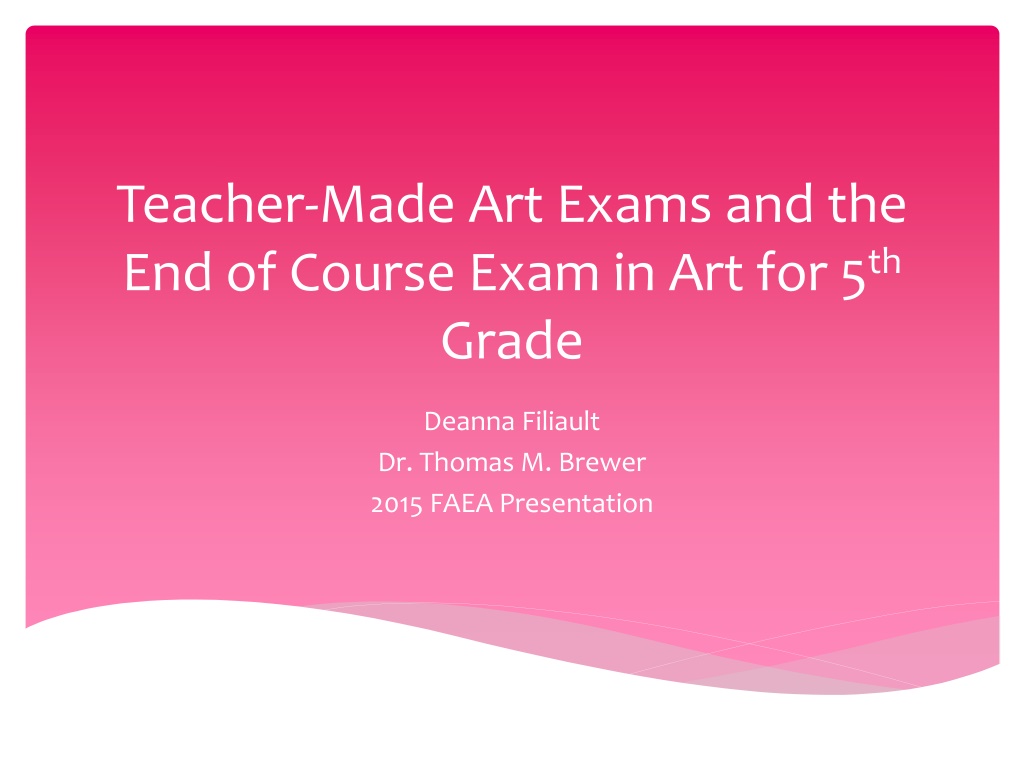
 undefined
undefined





